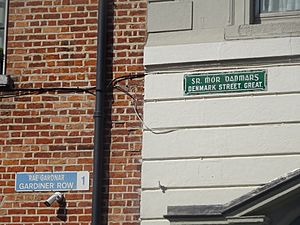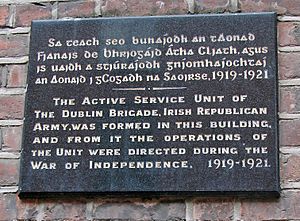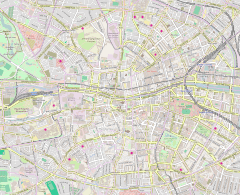Great Denmark Street facts for kids
| Sráid na Danmhairge Mhór (Irish) | |
| Denmark Street Great | |

Street signs at the point where Gardiner Row meets Great Denmark Street
|
|
| Namesake | Caroline Matilda, Queen Consort of Denmark and Norway |
|---|---|
| Length | 140 m (460 ft) |
| Width | 18 metres (59 ft) |
| Location | Dublin, Ireland |
| Postal code | D01 |
| Coordinates | 53°21′19″N 6°15′43″W / 53.35528°N 6.26194°W |
| west end | Gardiner Row, Rutland Place |
| east end | Gardiner Place, Hill Street, Temple Street |
| Other | |
| Known for | Belvedere College, O'Reilly Theatre, Olivier Cornet Gallery |

Great Denmark Street is a well-known street in Dublin, Ireland. It is also sometimes called Denmark Street Great. This street leads towards Mountjoy Square and crosses Temple Street/Hill Street. It is also part of Gardiner Row.
Contents
Discovering Great Denmark Street's Past
This area was mostly open land until the 1770s. That's when many large houses were built for wealthy families. The street was part of Gardiner Row until 1792.
The street might have been named in 1775 after Caroline Matilda of Great Britain. She was a sister of King George III and had married the Danish king Christian VII. Another idea is that it was named after Prince George of Denmark, who was married to Queen Anne. The word "Great" in its name helps tell it apart from Little Denmark Street. Little Denmark Street was a smaller lane that no longer exists today.
Famous Places and People
Many interesting people and places have been connected to Great Denmark Street.
Schools and Arts
At number 2, there was once a private school run by Reverend George Wright. A famous writer named Charles Lever went to this school. The school was a big rival of another private school on Grenville Street.
Today, number 3 is home to several groups that focus on art and culture. These include Fishamble: The New Play Company and the Olivier Cornet Gallery. The O'Reilly Theatre, a place for performances, is also located on Great Denmark Street. Michael O'Donovan, who used to be the director of the National Concert Hall, was born at number 15.
Belvedere College
One of the most important buildings on the street is Belvedere House. It was built in 1775 as a large house for George Rochfort, 2nd Earl of Belvedere. It cost a lot of money to build.
In 1841, Belvedere House became a Jesuit school called Belvedere College. Some people say that the ghost of Rochfort's mother, Mary Molesworth, 1st Lady of Belvedere, still haunts the house.
College Expansion and Changes
As the college grew in the 1900s, some old houses next to Belvedere House were taken down. In 1968, the college planned to remove two more houses. These houses were important and listed for preservation. One of them had a special interior designed by Michael Stapleton, an artist from the 1700s. However, these houses were taken down too early and without permission. New buildings were put in their place. In 1982, the college also removed another old house at number 9 to make the school playground bigger.



